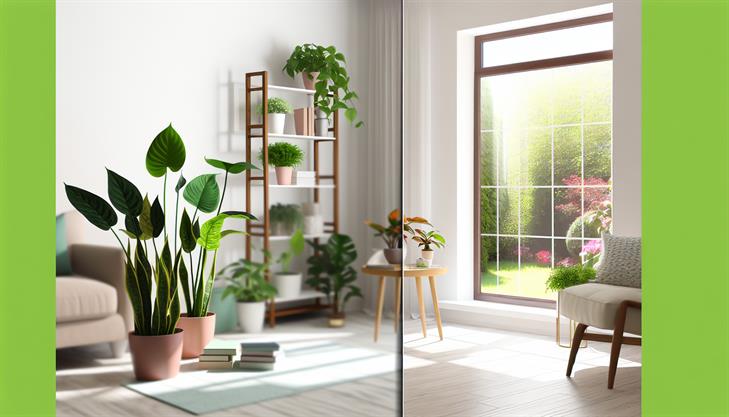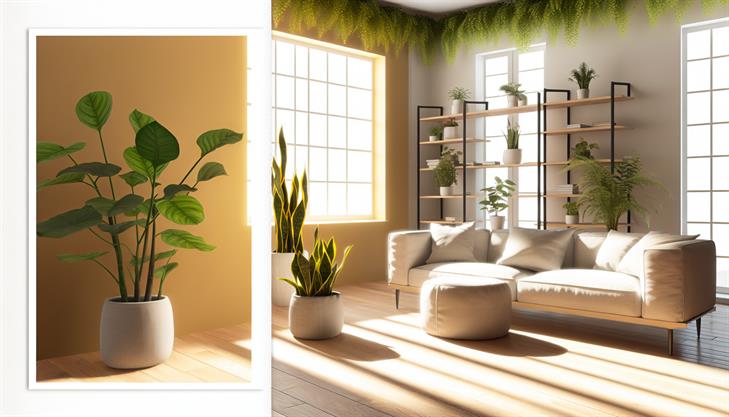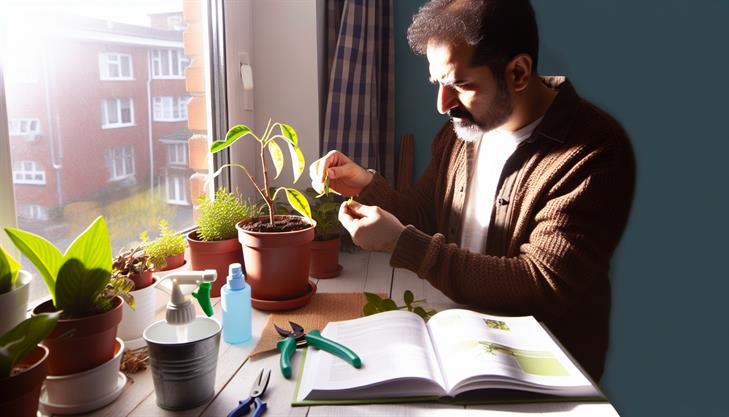In a world where the beauty of nature often beckons us to bring the outside in, houseplants have become beloved members of our indoor spaces, offering tranquility, improved air quality, and a splash of verdant elegance. Yet, as plant enthusiasts, we frequently face the tempting notion of giving our leafy companions a taste of the great outdoors, believing it might invigorate them with the natural elements they are inherently drawn to. Surprisingly, not all plants share this enthusiasm for the complexities of life beyond our cozy interior sanctuaries. In this insightful guide, we delve into the intriguing world of houseplants that prefer the comforts of home over the unpredictable allure of the outside. Understanding which plants thrive indoors while resisting the outdoor charm is crucial for nurturing a healthy plant collection. As you read on, you’ll discover why respecting these preferences can lead to flourishing foliage and a more harmonious growing environment in your home. Whether you’re a seasoned plant aficionado or a budding green thumb, this exploration uncovers essential tips and insights to keep your indoor oasis thriving.
Understanding Indoor vs. Outdoor Plant Needs
Many plant enthusiasts wonder, "Are there houseplants that don’t like to be outdoors?" Understanding the specific needs of indoor plants versus outdoor plants is essential for their thriving health and beauty. While some houseplants enjoy the seasonal transition to outdoor living, others are strictly indoor plants, preferring the controlled environment of our homes.
Why Some Houseplants Prefer to Stay Indoors
Houseplants that don’t thrive outdoors typically have specific needs regarding temperature, humidity, and light that are more easily controlled indoors:
-
Temperature Sensitivity: Many tropical houseplants, such as the peace lily or pothos, suffer when exposed to the cooler nighttime temperatures that occur in many regions, even in summer. Indoors, they enjoy consistent warmth.
-
Humidity Requirements: Plants like ferns and calatheas need high humidity, which can be difficult to maintain outside, particularly in drier climates. Indoor environments, especially when aided by humidifiers, are more suitable for these moisture-loving species.
-
Light Conditions: Some plants prefer indirect light, which is easier to manage indoors. For example, the snake plant and ZZ plant can suffer from too much direct sunlight, leading to scorched leaves.
Common Issues with Moving Indoor Plants Outdoors
-
Pests and Diseases: Moving houseplants outdoors can expose them to pests such as spider mites and aphids, which aren’t as prevalent indoors. If you must place indoor plants outside, regularly inspect and treat them for pests.
-
Environmental Stress: Rapid changes in environmental conditions can stress plants. Sudden exposure to harsher outdoor elements like wind or heavy rainfall can damage delicate foliage.
Tips for Setting Up Houseplants Indoors
-
Choose the Right Spot: Different plants thrive in various light conditions. Investigate each plant’s specific needs and place them in suitable locations, such as windowsills for light-loving varieties and shaded areas for those requiring indirect light.
-
Monitor Humidity and Temperature: Use a humidifier or pebble tray to maintain humidity, especially during winter when heating can dry the air. Keep indoor temperatures steady and avoid drafty spots or heaters.
-
Water Carefully: Indoor plants often need less water than when outdoors due to reduced evaporation. Ensure proper drainage to avoid root rot and water only when necessary.
Additional Advice
-
Acclimation: If you decide to move a typically indoor plant outside momentarily, gradually acclimate it to prevent shock. Start by placing it in a shaded outdoor area for short periods before gradually increasing exposure.
-
Research: Study your specific plant species. Resources like plant care guides or apps can offer tailored advice for individual plant preferences.
By understanding the unique requirements of your indoor plants, you can create an environment where they thrive, lush and healthy, without moving them outside. Remember, the more aligned you are with their natural habitat needs, even within the confines of your home, the more likely they are to flourish.
Indoor Plants That Prefer Staying Inside
While many plants thrive on the patio or in the garden during the warmer months, there are certain houseplants that are perfectly content staying inside all year round. These plants not only adapt well to the indoor environment but may actually experience stress or damage if exposed to outdoor conditions. Understanding which houseplants prefer the stable climate of your home can help you maintain a healthy and vibrant indoor garden.
Houseplants That Thrive Indoors
**1. African Violets: Known for their delicate flowers and lush foliage, African violets flourish in stable, controlled temperatures—conditions that are hard to maintain outdoors. They prefer indirect light as direct sunlight can scorch their leaves. To ensure they stay healthy, place them on a bright windowsill where they get plenty of filtered light.
**2. Spider Plants: These resilient plants are excellent for indoor growth. They thrive in moderate indirect light and enjoy the consistent temperatures found indoors. When placed outside, they can be affected by harsh winds or varying temperatures, which can stunt their growth or cause leaves to brown.
**3. Peace Lilies: With their elegant white blooms, peace lilies are sensitive to direct sunlight, which can burn their leaves. They enjoy humid environments, making the indoors ideal especially if you run a humidifier. Additionally, they benefit from the stable humidity levels and indirect light typical of indoor spaces.
Common Issues When Transitioning Outdoors
When indoor plants are moved outside, they may encounter several stress factors including:
- Sun Exposure: Unlike the filtered indoor light, direct outdoor sunlight can cause leaf burn.
- Temperature Fluctuations: Many houseplants are adapted to stable indoor climates and can struggle in fluctuating outdoor temperatures.
- Pests: Outdoor environments expose plants to a range of pests not commonly found indoors, which can lead to infestations.
Setting Up the Perfect Indoor Environment
Lighting: Use sheer curtains to diffuse natural light or consider artificial plant lights if your space is low in sunlight.
Humidity: Many indoor plants, such as ferns and orchids, enjoy higher humidity levels. Grouping plants together or using a pebble tray with water can help increase local humidity.
Temperature: Avoid placing plants near drafts or heat sources such as radiators that can cause rapid changes in temperature. Indoor plants generally thrive between 65°F to 75°F (18°C to 24°C).
Additional Tips
- Watering: Indoor environments vary greatly, so check soil moisture levels before watering. Overwatering is a common issue leading to root rot, particularly when humidity is higher indoors.
- Dusting Leaves: Keep leaves free from dust to ensure maximum photosynthesis. A monthly wipe-down with a damp cloth can help.
- Fertilization: Because many indoor plants experience less growth compared to those outside, they need less frequent fertilization. Use a diluted solution about every six weeks during the growing season.
These houseplants offer you lush greenery and aesthetic beauty without requiring a move to the great outdoors. Enjoy the benefits of gardening comfortably inside by choosing plants that prefer to stay indoors.
Tips for Creating the Perfect Indoor Environment
When crafting the perfect indoor environment, understanding the nature of houseplants can greatly enhance your living space. If you’re wondering, "are there houseplants that don’t like to be outdoors?" the answer is a resounding yes. Many houseplants thrive indoors due to specific environmental needs that are difficult to replicate outside. Below, we explore these plants and provide tips for nurturing them effectively in your home.
Understanding Why Some Houseplants Prefer Indoors
Several houseplants are native to tropical climates, where they grow under the canopy of larger trees in the shade, with stable temperatures and high humidity. Outdoor conditions, with fluctuating temperatures, harsh direct sunlight, and wind, can stress these plants. Common indoor plants that typically do not fare well outdoors include:
-
Peace Lily (Spathiphyllum): Preferring low light and high humidity, Peace Lilies can suffer from outdoor exposure, especially in direct sunlight or windy conditions.
-
Snake Plant (Sansevieria): This hardy plant thrives best when shielded from direct sun and rapid temperature changes, making an indoor environment ideal.
-
Pothos (Epipremnum aureum): Known for its adaptability, Pothos can still get sunburned from intense sunlight, making indoor conditions more suitable.
Tips for Nurturing Indoor-Only Houseplants
To create a thriving indoor environment for these sensitive plants, consider the following steps:
-
Light Management: Position these plants in areas with indirect sunlight to mimic their native habitat. North or east-facing windows often provide the perfect light without over-exposing the plants.
-
Temperature Control: Maintain stable indoor temperatures, ideally between 65-75°F (18-24°C). Avoid placing plants near drafty windows, doors, or heating vents that can lead to temperature fluctuations.
-
Humidity Levels: Since many of these plants originate from humid tropical environments, increasing indoor humidity can benefit them. Place a humidifier nearby, or use a pebble tray filled with water under the pot to boost humidity levels.
-
Watering Practices: Overwatering is a common issue for indoor plants. Use pots with drainage holes and follow a schedule based on each plant’s specific needs. Allow the soil to dry out slightly between waterings.
-
Avoiding Pest Problems: Indoor environments can attract pests like spider mites or aphids. Regularly check the leaves for signs of infestations and treat appropriately with organic pesticide or insecticidal soap if needed.
Additional Advice for Indoor Plant Care
-
Rotate Plants: To ensure even growth, rotate your plants periodically. This will prevent them from leaning toward the light source.
-
Regular Cleaning: Dust can accumulate on leaves, hindering photosynthesis. Wipe leaves with a damp cloth periodically to keep them clean and healthy.
-
Use Appropriate Soil: Each plant type benefits from specific soil types, such as a well-draining potting mix for Snake Plants or an indoor plants mix for Pothos.
Creating the perfect indoor environment for plants that don’t like to be outdoors requires understanding and adjusting to their natural preferences. By implementing these practices, you can ensure these houseplants thrive, bringing beauty and health benefits to your indoor space.
Troubleshooting Common Indoor Plant Issues
While it might seem natural to assume that all plants enjoy being outside, certain houseplants actually thrive better indoors and don’t appreciate the change in environment. These indoor-only plants are typically adapted to the stable conditions found within a home, which means they can be more sensitive to the fluctuations present outdoors.
Indoor Plants Unsuited for Outdoor Environments
-
Orchids
Orchids are known for their delicate beauty and can be quite sensitive to the elements. Factors such as wind, rain, and temperature variations can stress these plants. Indoors, they benefit from stable temperatures and controlled humidity, whether it’s through an orchid-specific potting mix or proper placement in a room. -
African Violets
African violets thrive in a consistent indoor climate. They dislike direct sunlight, which can scorch their leaves, and abrupt weather changes can lead to stress and damage. Ensure they are placed in indirect bright light inside your home to mimic their natural environment. -
Peace Lilies
Peace lilies prefer the controlled climate of an indoor setting. Exposure to direct outdoor light and fluctuating temperatures can cause their leaves to brown at the tips. They do best in shaded indoor areas where they can receive consistent moisture and light. -
Calatheas
Known for their dramatic foliage, Calatheas appreciate humidity and steady warmth. By placing them outdoors, they might experience the harsh impact of direct sunlight or excessive airflow, which can curl their leaves or stunt growth.
Tips for Keeping Sensitive Houseplants Indoors
-
Consistent Temperature Control: Maintain a stable indoor temperature to keep these sensitive plants comfortable. Most indoor plants prefer temperatures between 65-75°F (18-24°C).
-
Avoid Direct Sunlight: Position your plants where they can receive indirect light. Use sheer curtains to filter sunlight if necessary, as direct exposure can cause leaf burn.
-
Right Humidity Levels: Use a humidifier to keep humidity levels between 40-60%, especially during winter months when indoor heating can dry the air.
-
Correct Watering Practices: Over-watering can be as harmful as under-watering. Ensure the pots have drainage holes and only water when the topsoil feels dry to the touch.
Common Indoor Plant Issues
-
Pest Infestations: Keep an eye out for pests like aphids or spider mites. Use natural insecticidal soap to treat infestations.
-
Fungal Growth: Proper air circulation and avoiding water splashes on leaves can prevent fungus-related issues.
-
Nutrient Deficiency: Yellowing leaves can indicate a lack of nutrients. Utilize a balanced indoor plant fertilizer according to the plant’s specific needs.
Additional Advice
To further protect these houseplants from the outdoors, avoid sudden relocations or exposure by keeping windows closed during temperature extremes and storms. Regularly cleaning leaves with a damp cloth can also help your plants to breathe better and reduce dust accumulation, ensuring they stay healthy inside.
By understanding and respecting the preferences of these indoor houseplants, you can ensure they remain healthy, vibrant, and free from the stressors of outdoor conditions.
Essential Tools for Happy Indoor Houseplants
Many houseplant enthusiasts often wonder, "Are there houseplants that don’t like to be outdoors?" The simple answer is yes. Several houseplants thrive exclusively indoors due to their natural habitat preferences and sensitivity to external environmental conditions. Understanding which plants are better suited to indoor environments can help you cultivate a healthy and vibrant interior garden. Let’s explore some common houseplants that generally prefer staying indoors and provide guidance on how to care for them.
-
Understanding Indoor Preferences:
- Tropical Origins: Many houseplants originally come from tropical regions where the climate is stable year-round. Unlike outdoor environments, tropical plants need consistent humidity, temperature, and light levels, which are more easily controlled indoors.
- Light Sensitivity: Certain houseplants are sensitive to direct sunlight, which can scorch their leaves. Indoors, they can benefit from indirect or filtered light sources that mimic their natural shaded forest habitats.
-
Examples of Indoor-Preferred Houseplants:
- Snake Plant (Sansevieria): This hardy plant is perfect for indoors as it tolerates low light conditions. Outdoors, direct sun can cause the leaves to lose their vibrant color.
- Peace Lily (Spathiphyllum): Preferring low to medium indirect light, the Peace Lily can suffer from stress if exposed to direct outdoor sunlight or drafts.
- Boston Fern (Nephrolepis exaltata): With a need for high humidity and consistent temperatures, the Boston Fern flourishes when kept inside, away from the unpredictable outdoor weather.
-
Common Issues and Solutions:
- Humidity Control: Many indoor-only plants thrive in higher humidity levels, which can be difficult to maintain outside. Use a humidifier or place a tray of water near the plants to increase ambient moisture.
- Temperature Regulation: Avoid exposing indoor plants to temperature extremes. Constant indoor temperatures (typically between 60-75°F) are ideal.
- Protecting from Pests: Outdoor conditions expose plants to pests. Regularly inspect indoor plants for signs of infestation and treat appropriately.
-
Setup Tips:
- Proper Location: Choose spots in your home that match each plant’s light and temperature requirements. East or north-facing windows often provide gentle light exposure.
- Appropriate Potting: Opt for pots with good drainage to prevent root rot, a common indoor plant issue. Choose a potting mix suited to each plant’s specific needs.
- Regular Watering Routine: Develop a consistent watering schedule, adjusting frequency according to season and plant type. Most indoor plants do not need as much water in winter.
-
Additional Advice:
- Monitor Plant Health: Keep an eye on the condition of your houseplants. Wilting, discoloration, or leggy growth may indicate inadequate light or drafts.
- Experiment with Plant Placement: Don’t be afraid to move plants around your home to find their ideal growing spot. Remember, changes may take time, so be patient and observe their response.
By understanding the conditions that indoor-preferring houseplants need, you can successfully cultivate a thriving green space within your home without the risks associated with outdoor elements. Whether you are dealing with light-sensitive foliage or tropical humidity lovers, indoor environments can offer the perfect sanctuary for these resilient plants.
In conclusion, while many houseplants thrive in outdoor environments, there are several varieties that prefer the controlled conditions of indoor living. Key points to remember include the fact that some plants, like ferns, orchids, and certain tropical species, are sensitive to temperature fluctuations, direct sunlight, and wind. Understanding the natural habitat of your houseplants can guide you in creating a suitable indoor environment that mimics their original ecosystem. Applying what you’ve learned, it’s crucial to monitor factors like light, temperature, and humidity levels, and consult plant-specific care guides to determine the best conditions for each species.
As a final tip, when introducing or shifting plants between indoors and outdoors, make adjustments gradually to avoid shocking the plant. This could involve acclimating them to new light conditions over several days. Remember, the key to successful plant care is attentiveness and adaptability. By tuning into the needs of your houseplants, you can ensure they flourish in your indoor sanctuary.


